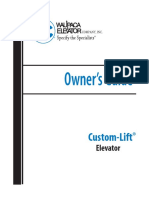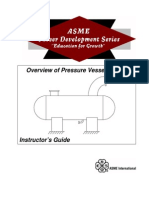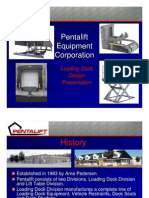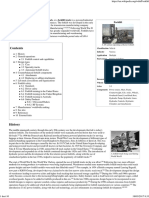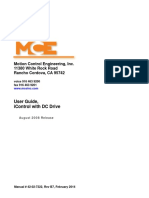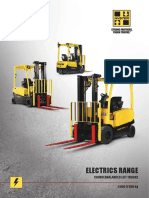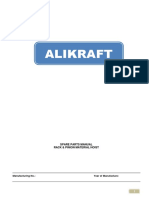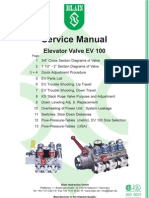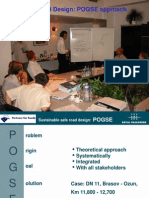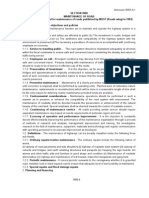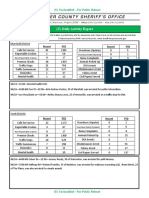1 June 2014 Dock Levelers 101
1 June 2014 Dock Levelers 101
Uploaded by
teguheafCopyright:
Available Formats
1 June 2014 Dock Levelers 101
1 June 2014 Dock Levelers 101
Uploaded by
teguheafOriginal Description:
Original Title
Copyright
Available Formats
Share this document
Did you find this document useful?
Is this content inappropriate?
Copyright:
Available Formats
1 June 2014 Dock Levelers 101
1 June 2014 Dock Levelers 101
Uploaded by
teguheafCopyright:
Available Formats
1 Dock Levelers 101 June 2014
What You Always Wanted to Know
About Dock Levelers But Were Afraid
to Ask
Just what the heck is a dock leveler?
A dock leveler is a piece of equipment that is usually either mounted to the dock face
or recessed into a pit at a loading dock door allowing movement of industrial vehicles
between a building and a transport vehicle.
June 2014 Dock Levelers 101 2
Common Terms and Definitions
What do I need to know before I can start selecting a dock leveler
for my application?
You might want to know some common terms and definitions:
Lip
Activation System
Deck
Toe Guard
Dock Pit
Dock
Bumpers
Frame Shim
3 Dock Levelers 101 June 2014
Common Terms and Definitions
Activation System: The activation system provides the motive power of the dock leveler. These
systems may or may not require external power interfaces. Typical activation systems are mechanical
(springs), pneumatic (air bladders) and hydraulic.
Attachments: This term refers to implements that can be added to a fork truck for handling a load.
Attachments such as clamps, slip sheet forks and carpet poles can have an effect on capacity and
should be considered in selecting a dock leveler.
Bumpers: These are used to prevent the transport vehicle from directly contacting and damaging
the building, dock leveler or vehicle restraint. They are usually made of rubber. Bumper sizes and
projections vary, based on vehicles serviced and other factors such as driveway slope.
Capacity: The manufacturer’s capacity tag rating may not reflect the gross roll-over load for a specific
dock leveler. Capacity is the rating of the load that the manufacturer of the dock leveler deems to be
appropriate for the design, based on considerations of the characteristics of the user’s application.
The required capacity of a dock leveler for a specific application is usually determined by taking the
GVW and applying a complexity factor to it. The complexity factor is typically determined by a set of
characteristics that are present at the particular application. These characteristics may include, but are
not limited to: the heaviest fork lift and load (GVW) being driven across the dock leveler; the number of
fork lift cycles driving across the dock leveler; the speed of fork lift moving across the dock leveler; the
life expectation of the dock leveler; the loading slope above or below dock level; the use of three vs four
wheel lift trucks; whether there are attachments on the front end of the lift truck; the lip length as well as
other considerations. The authorized sales representative of the manufacturer can help determine the
capacity of the dock leveler that is required for a specific application.
Deck: The deck assembly is the major part of the structure that is driven over. Most decks have
some type of anti-skid surface such as a tread plate surface to provide traction at the various working
angles. The deck assembly pivots at the back end of the dock leveler - the end of the dock leveler that
is furthest from the transport vehicle. The dock leveler has a hinged lip attached to the other end.
Dock: This is the area of a building where loading and/or unloading of transport vehicles takes place.
Dock Level: This term involves the vertical level that conforms to the building’s floor surface.
June 2014 Dock Levelers 101 4
Common Terms and Definitions
Dock Pit: The pit is the recessed opening in the building’s floor that accommodates the pit dock leveler.
Most pits are lined along the edges with structural steel angles that are embedded in the concrete.
Frame: The frame assembly is the supporting structure for a dock leveler.
Gross Vehicle Weight (GVW): The GVW is the combined weight of the material handling equipment
(lift truck, pallet jack, etc) and the load. In other words, it is the total maximum weight moving across
the dock leveler.
Lip: The lip assembly is usually pivotally attached to the deck assembly and pivots from a vertical
stored position to a position that rests on the transport vehicle’s floor. Lips are usually made with a
tread plate that is similar to the deck.
Load: The load is the weight of a typical individual pallet on a transport vehicle. For typical capacity
calculations there are a maximum of (20) twenty loads per transport vehicle.
Shift: This term refers to the working shift at the building. For capacity calculation purposes, a typical
capacity calculation would involve a maximum of (8) eight trailers per shift.
Shim: These are steel plates that maybe used to help level pit-mounted dock levelers. Shims may be
placed under the frame structure and would be welded in place in order to provide a structural load path
to the building’s foundation.
Toe Guard: It is a shield that is mounted flush to the side of a deck assembly in order to provide toe
protection when the dock leveler is above dock level.
Transport Vehicle: This is a cargo carrying vehicle such as a truck, semi-trailer, trailer or railcar.
Working Range: The recommended range of vertical travel above and below dock level for which
loading and unloading can take place.
5 Dock Levelers 101 June 2014
Types of Dock Levelers -
Pit Levelers
What kinds of dock levelers are there?
There are many different kinds of dock levelers. These include the following common types, but may
also include special designs that are unique to an individual manufacturer;
Pit leveler - This type of dock leveler is found in a recessed concrete opening in a building’s
concrete at the dock door. There are three major sub-categories of such pit levelers:
Mechanical Pit Leveler This is the most common of the
pit leveler category and typically the least expensive. This leveler
style uses a mechanical spring system to raise the leveler and is
typically “upward biased.” This means that the spring is tending
to force the leveler deck to rise up all of the time and a restraining
device is preventing that motion. No electrical power supply at the
dock is required for such a mechanical leveler. These levelers tend
to be the most expensive to service and to maintain over their life.
June 2014 Dock Levelers 101 6
Types of Dock Levelers -
Pit Levelers
Air Pit Leveler This type uses a pneumatic bag system
of some type to raise and lower the leveler deck. Obviously, this
leveler requires some type of electrical power source - either at
the dock or adjacent to it. Most typically, this power source would
be standard 110v power. Generally, these levelers are moderately
more expensive than mechanical levelers but can involve reduced
service and maintenance requirements when compared to
mechanical units.
Hydraulic Pit Leveler This is the most versatile of the pit
style levelers. A hydraulic cylinder is used to raise and to lower
the deck, while another is typically used to operate the lip. These
levelers may come in various configurations and may be powered
by everything from 110V single phase to 575V three-phase.
The hydraulic option gives you more versatility than either
mechanical or air dock levelers and typically would have lower
service and maintenance costs.
7 Dock Levelers 101 June 2014
Types of Dock Levelers -
Vertical & Rail Dock Levelers
Vertical Leveler A vertical leveler is exactly what the name
implies - a dock leveler that is stored in a vertical position. Why
is this desirable? This allows you to store the leveler inside the
building and to close your dock door on concrete, instead of across
the leveler, as is the case of a pit leveler. This should allow better
environmental control in your building. These vertical levelers are
often used in food service applications or areas where wash down
is an issue. Vertical levelers are typically pit or shelf-mounted and
hydraulically operated.
Rail Dock Leveler These levelers involve a variation
on the vertical leveler and are used to service rail cars. They
are usually mounted on a sliding rail that allows them to move
horizontally along the rail track. They may either be manually or
hydraulically moved along the track and are typically hydraulically
operated levelers.
June 2014 Dock Levelers 101 8
Types of Dock Levelers -
Edge of Dock (EOD) &
Top of Dock (TOD) Levelers
Edge of Dock (EOD) Leveler This is a simple device
that is usually mechanically operated but may be pneumatically or
hydraulically operated. It is often found mounted on the exterior
wall of a building with an integral bumper set but may also be pit
mounted. The EOD has a limited vertical operating range and
is geared toward applications where the transport vehicle bed is
at, or very near, the floor level of the building (dock level). These
units are generally inexpensive when compared to a pit or vertical
dock leveler but may be considered an upgrade from portable dock
boards as they are fixed to the dock face and have some form
of lift assistance (mechanical, air or hydraulic). A recommended
normal working range of an EOD is typically +/- 3 inches.
Top of Dock (TOD) Leveler This is a version of an
EOD leveler and is typically mounted to the floor surface and the
leading edge of the dock face of the building. It generally requires
minimal or no concrete work. The working range of these units is
intended to provide primarily above-dock working range.
9 Dock Levelers 101 June 2014
More Information
How do I find out more?
You can contact the Loading Dock Equipment Manufacturer’s website at
www.MHI.org/LODEM
At the time this resource document was published, LODEM consisted of the following
member companies:
4Front Entrematic
Blue Giant Equipment Corporation
Bluff Manufacturing, Inc.
NOVA Technology
Pentalift Equipment Corporation
Rite-Hite Corporation
Systems, Incorporated
DISCLAIMER OF LIABILITY. LODEM, the Material Handling Industry, MHI, and their members assume no re-
sponsibility and disclaim all liability of any kind, however arising, as a result of acceptance or use or alleged use
of this Guide. User specifically understands and agrees that LODEM, the Material Handling Industry, MHI, their
members, their officers, agents, and employees shall not be liable under any legal theory of any kind for any
action or failure to act with respect to the proper selection of a material handling system as well as matters such
as the service for which it will be used, the frequency of its use, matching its speed with manufacturing needs,
budget or any other activity covered by This Guide. Any use of this information must be determined by the user
to be in accordance with applicable federal, state, and local laws and regulations.
DISCLAIMER OF WARRANTY. LODEM, the Material Handling Industry, MHI, and their members make NO
WARRANTIES of any kind, express, implied, or statutory, in connection with the information in this Guide and
SPECIFICALLY DISCLAIM ALL IMPLIED WARRANTIES OF MERCHANTABILITY AND OF FITNESS FOR
PARTICULAR PURPOSE.
INDEMNIFICATION. By referring to or otherwise employing This Guide, the user agrees to defend, protect,
indemnify, and hold LODEM, the Material Handling Industry, MHI, their members, their officers, agents, and em-
ployees harmless from and against all claims, losses, expenses, damages, and liabilities, direct, incidental, or
consequential, arising from acceptance or use or alleged use of this Guide, including loss of profits and reason-
able attorneys’ fees which may arise out of the acceptance or use or alleged use of this Guide. The intent of this
provision and of the user is to absolve and protect LODEM, the Material Handling Industry, MHI, their members,
their officers, agents, and employees from any and all loss relating in any way to this Guide, including those
resulting from the user’s own negligence.
June 2014 Dock Levelers 101 10
Notes
11 Dock Levelers 101 June 2014
June 2014 Dock Levelers 101 12
© LODEM 2012
You might also like
- Baker Fork Truck FJF-040Document3 pagesBaker Fork Truck FJF-040Otis Rainwater0% (1)
- Owner's Guide: Paca-LiftDocument16 pagesOwner's Guide: Paca-LiftfreddyjoertyNo ratings yet
- Owner's Guide: Custom-LiftDocument16 pagesOwner's Guide: Custom-LiftfreddyjoertyNo ratings yet
- Installationmanual LiftDocument20 pagesInstallationmanual LiftSyed iliyasNo ratings yet
- 2020 Dockzilla Loading Dock Buyers GuideDocument11 pages2020 Dockzilla Loading Dock Buyers GuideNadeem RazaNo ratings yet
- SavariaDocument14 pagesSavariaJenny QuachNo ratings yet
- Owner's Guide: Winding Drum Residential ElevatorDocument28 pagesOwner's Guide: Winding Drum Residential ElevatorAgnelo FernandesNo ratings yet
- Pressure Vessel Design ASME GuideDocument137 pagesPressure Vessel Design ASME Guidesmasudbd100% (17)
- Dock Design Slide PresentationDocument52 pagesDock Design Slide PresentationSchoeman_DanieNo ratings yet
- LiftDocument43 pagesLiftalyajimmy11No ratings yet
- Owner'S / Operator'S ManualDocument20 pagesOwner'S / Operator'S ManualSpyder007No ratings yet
- 411-254-0EI Hydraulic EdgeofDock InstallationOwnersManualDocument24 pages411-254-0EI Hydraulic EdgeofDock InstallationOwnersManualUttam Kumar GhoshNo ratings yet
- Pressure Switch Series 200Document4 pagesPressure Switch Series 200amitdharmapurikar100% (1)
- Guide D'Utilisation: Operating ManualDocument16 pagesGuide D'Utilisation: Operating ManualnameNo ratings yet
- Forklift - WikipediaDocument10 pagesForklift - WikipediaFajrin M. NatsirNo ratings yet
- VFC Manual PDFDocument28 pagesVFC Manual PDFFikret DavudovNo ratings yet
- Coffing LSB Manual MICASDocument16 pagesCoffing LSB Manual MICASGuatemalan1979100% (1)
- Operating Manual Os030beDocument16 pagesOperating Manual Os030beSANDRA NOGUERANo ratings yet
- Maber MB 2000Document1 pageMaber MB 2000Kalauz EdmondNo ratings yet
- 02 Hoist IntroDocument100 pages02 Hoist IntroJuan Carlos Gonzales VelezmoroNo ratings yet
- Hydraulic Elevators Basic ComponentsDocument16 pagesHydraulic Elevators Basic ComponentsIkhwan Nasir100% (2)
- Dock LevelersDocument12 pagesDock Levelersrochim_putech_126885No ratings yet
- Year Full Load Test Elevator Contractor SOWDocument2 pagesYear Full Load Test Elevator Contractor SOWJoseNo ratings yet
- Om Phi0101 Stressing Jacks 5DA1 6DA1Document8 pagesOm Phi0101 Stressing Jacks 5DA1 6DA1Atul SalveNo ratings yet
- 42-02-G004 B4 Motion GroupDocument86 pages42-02-G004 B4 Motion GroupElputoAmo XDNo ratings yet
- LM380A Instruction Manual in Eng PDFDocument64 pagesLM380A Instruction Manual in Eng PDFJuli RokhmadNo ratings yet
- Icontrol DC Aug 08 Rel 42-02-7222 B7Document788 pagesIcontrol DC Aug 08 Rel 42-02-7222 B7ElputoAmo XDNo ratings yet
- Kleemann NewsFax/Mail (082011) English VersionDocument4 pagesKleemann NewsFax/Mail (082011) English VersionKleemmann Hellas SANo ratings yet
- I ControlDocument740 pagesI Controloswaldo moraNo ratings yet
- HKIFM CPD Lifts and EscalatorsDocument41 pagesHKIFM CPD Lifts and EscalatorsJames ChanNo ratings yet
- FP-07 - All Home Cdo - 070317 PDFDocument1 pageFP-07 - All Home Cdo - 070317 PDFLowentan LaxamanaNo ratings yet
- 2011 Vacon NA Drives Product Catalog 8 2011Document100 pages2011 Vacon NA Drives Product Catalog 8 2011Miguel Vargas100% (2)
- Express Nomenclature Pocket BookDocument21 pagesExpress Nomenclature Pocket BookJibjab7100% (1)
- Wheelchair Lift Genesis Shaftway Specification 16993 DSDocument7 pagesWheelchair Lift Genesis Shaftway Specification 16993 DSDiegoNo ratings yet
- Hydraulic Lift 29.5.13.Document63 pagesHydraulic Lift 29.5.13.Rajat Srivastava50% (2)
- MontacargasDocument13 pagesMontacargasAbi Zuñiga50% (2)
- Yale 13500Document6 pagesYale 13500VitorMelloNo ratings yet
- Alimak Se-Ex: Passenger and Goods Lifts For Hazardous AreasDocument8 pagesAlimak Se-Ex: Passenger and Goods Lifts For Hazardous AreasJod RichNo ratings yet
- Elevator History and Functions and The Invention of This Amazing Piece of WorkDocument69 pagesElevator History and Functions and The Invention of This Amazing Piece of Workjay vallejosNo ratings yet
- Wittur Range of Elevators: Your Global Partner For Components, Modules and Systems in The Elevator IndustryDocument4 pagesWittur Range of Elevators: Your Global Partner For Components, Modules and Systems in The Elevator IndustryMohd Abu AjajNo ratings yet
- Owner's Guide: ExcelevatorDocument16 pagesOwner's Guide: ExcelevatorfreddyjoertyNo ratings yet
- Round Elevator Specification TableDocument1 pageRound Elevator Specification TableRalu AlexandraNo ratings yet
- Material Hoist - Spare Parts ManualDocument42 pagesMaterial Hoist - Spare Parts ManualRajesh PanchalNo ratings yet
- Gearless Machines For Elevators: Lift Range 2014Document8 pagesGearless Machines For Elevators: Lift Range 2014Khaled ZakariaNo ratings yet
- Hollister Whitney CatlogDocument77 pagesHollister Whitney Catlogleibyberger0No ratings yet
- EC20 Series PLC User Manual PDFDocument51 pagesEC20 Series PLC User Manual PDFRafael Cueva AmayaNo ratings yet
- ElevatorsDocument11 pagesElevatorsDalia M-aNo ratings yet
- Car Parking SP SystemDocument4 pagesCar Parking SP System61engineer61No ratings yet
- Blain Service Manual LowDocument15 pagesBlain Service Manual LowSylvester SullivanNo ratings yet
- Beh Fx2000 ManualDocument32 pagesBeh Fx2000 ManualSvedot Makedonec100% (1)
- GuideDocument20 pagesGuideskannan6747No ratings yet
- Wire Rope Hoist AustrDocument11 pagesWire Rope Hoist AustrJESUSCALVILLONo ratings yet
- Synchronized Telescopic Cylinder ManualDocument23 pagesSynchronized Telescopic Cylinder ManualMohamed SemedaNo ratings yet
- Vision Elevators Company ProfileDocument8 pagesVision Elevators Company ProfileMotlatjo RakgothoNo ratings yet
- Motion 2000 Hydraulic v8 42-02-1P20 B7Document248 pagesMotion 2000 Hydraulic v8 42-02-1P20 B7ElputoAmo XD100% (1)
- Savaria V-1504 Vertical Platform: Versatility For Any ApplicationDocument4 pagesSavaria V-1504 Vertical Platform: Versatility For Any ApplicationarqnoehvNo ratings yet
- AMWP8-9.5-1200-Operators ManualDocument80 pagesAMWP8-9.5-1200-Operators ManualpetrusNo ratings yet
- Edge of Dock Leveler Vs Pit LevelerDocument1 pageEdge of Dock Leveler Vs Pit LevelerVinod Kumar ViswanathanNo ratings yet
- Ppt:-Deck MachineryDocument35 pagesPpt:-Deck Machineryaimri_cochin81% (32)
- Electroflocculation in The Treatment of Polluted WDocument13 pagesElectroflocculation in The Treatment of Polluted WteguheafNo ratings yet
- SeriesDocument4 pagesSeriesteguheafNo ratings yet
- Agitators enDocument17 pagesAgitators enteguheafNo ratings yet
- Coating Tachnology HandbookDocument4 pagesCoating Tachnology HandbookteguheafNo ratings yet
- Ucf 200 and 300 SeriesDocument4 pagesUcf 200 and 300 SeriesteguheafNo ratings yet
- NTN Pillow BlockDocument54 pagesNTN Pillow BlockteguheafNo ratings yet
- Civic C Entre: Design StudioDocument25 pagesCivic C Entre: Design StudioBala CNo ratings yet
- Cranes: Excavating EquipmentsDocument17 pagesCranes: Excavating EquipmentszarkimaNo ratings yet
- Pedestrian Environmental Quality Index Draft Data ManualDocument30 pagesPedestrian Environmental Quality Index Draft Data ManualprowagNo ratings yet
- Potsdam Village Police Dept. Blotter Aug. 31, 2014Document6 pagesPotsdam Village Police Dept. Blotter Aug. 31, 2014NewzjunkyNo ratings yet
- Arizona Racial Profiling Report Driving Black or BrownDocument13 pagesArizona Racial Profiling Report Driving Black or BrownBrenda NorrellNo ratings yet
- Chapter 01-3 Relative VelocityDocument2 pagesChapter 01-3 Relative VelocityalvinhimNo ratings yet
- Great Manual Manufacturing, IncDocument17 pagesGreat Manual Manufacturing, Incpandi_ckpNo ratings yet
- محاضرة رقم 9Document7 pagesمحاضرة رقم 9Zainab A. AbdulstaarNo ratings yet
- 11 Chapter 5Document77 pages11 Chapter 5AbhijeetSinghNo ratings yet
- RH PogseDocument26 pagesRH PogsePatrick DavisNo ratings yet
- Annexure 3000 A.1 Manual of Roads Maintenance IRCDocument38 pagesAnnexure 3000 A.1 Manual of Roads Maintenance IRCErMelvinDias50% (2)
- Ground PressureDocument7 pagesGround PressurenathansolaiNo ratings yet
- (U) Daily Activity Report: Marshall DistrictDocument6 pages(U) Daily Activity Report: Marshall DistrictFauquier NowNo ratings yet
- Chapter 4Document70 pagesChapter 4hemysbakery45No ratings yet
- WTM Classified Adverts 140115Document6 pagesWTM Classified Adverts 140115Digital MediaNo ratings yet
- Lv3.Unit 45Document7 pagesLv3.Unit 45amritessNo ratings yet
- What Is Your City Like - General - Grammar - Too Much, Too Many, (Not) EnoughDocument21 pagesWhat Is Your City Like - General - Grammar - Too Much, Too Many, (Not) EnoughLucia CampoNo ratings yet
- Terex Finlay 863 (English) PDFDocument4 pagesTerex Finlay 863 (English) PDFsherylinlaNo ratings yet
- ProjectDocument6 pagesProjectJNfotoeventsNo ratings yet
- Adaptive Air Suspension in Automobiles: A Case Study: Iterature ReviewDocument4 pagesAdaptive Air Suspension in Automobiles: A Case Study: Iterature ReviewSEELAM HARSHAVARDHANREDDYNo ratings yet
- ABG 5820 6820 7820 8820 en (E71)Document12 pagesABG 5820 6820 7820 8820 en (E71)San100% (1)
- Solapur To Bijapur Exe Summary Draft Eia PDFDocument141 pagesSolapur To Bijapur Exe Summary Draft Eia PDFPIU DHAMTARINo ratings yet
- Indian Standards List (Roads)Document6 pagesIndian Standards List (Roads)SAAKSH DEGITECHNo ratings yet
- Recon SurveyDocument4 pagesRecon Surveydareymayree56No ratings yet
- Trident Paints_Infraleads_Jan 1, 2024-May 15, 2024 (1)Document364 pagesTrident Paints_Infraleads_Jan 1, 2024-May 15, 2024 (1)Bridal StylenewNo ratings yet
- SSYMA-P03.14-F01 Formato de BOW TIE (Exposicion A Polvo)Document2 pagesSSYMA-P03.14-F01 Formato de BOW TIE (Exposicion A Polvo)Eileen CornelioNo ratings yet
- Banksman Barricades and SignsDocument15 pagesBanksman Barricades and SignsAmirNo ratings yet
- Principles of ManagementDocument21 pagesPrinciples of ManagementShrikant DarneNo ratings yet
- Wheel Load AnalysisDocument8 pagesWheel Load Analysistsoheil100% (2)
- 01 CPE Entry TestDocument8 pages01 CPE Entry TestMilaNo ratings yet


